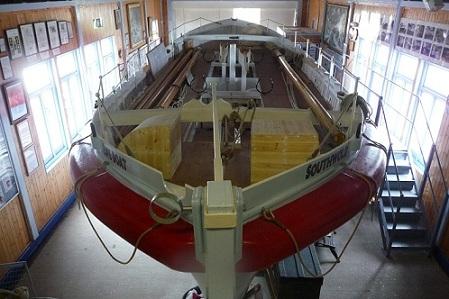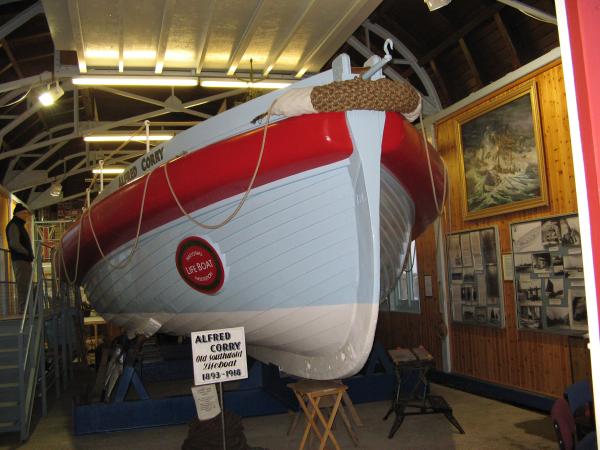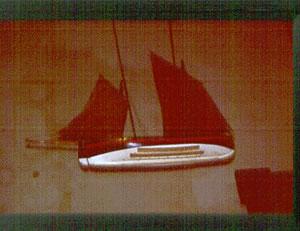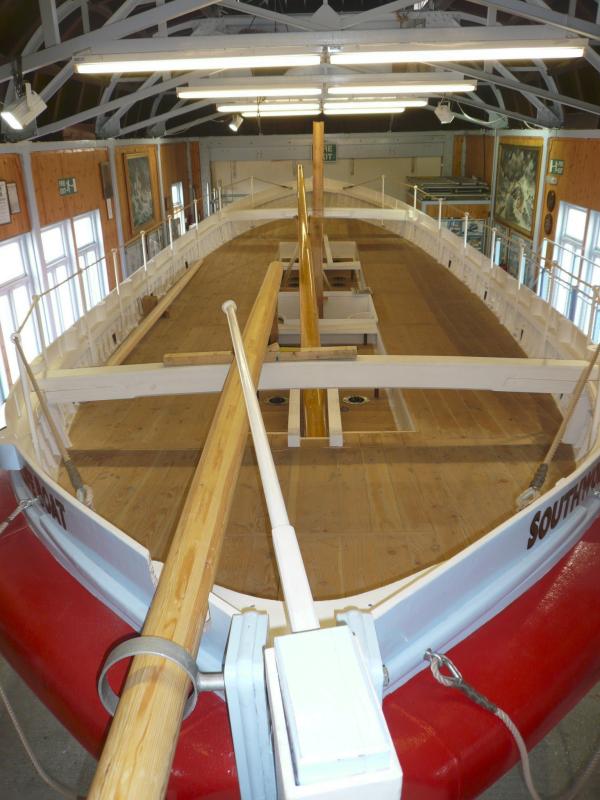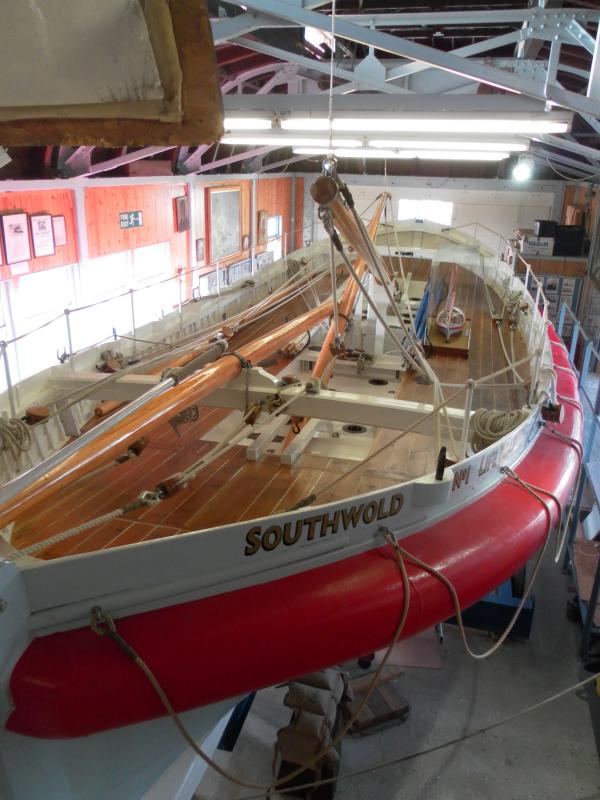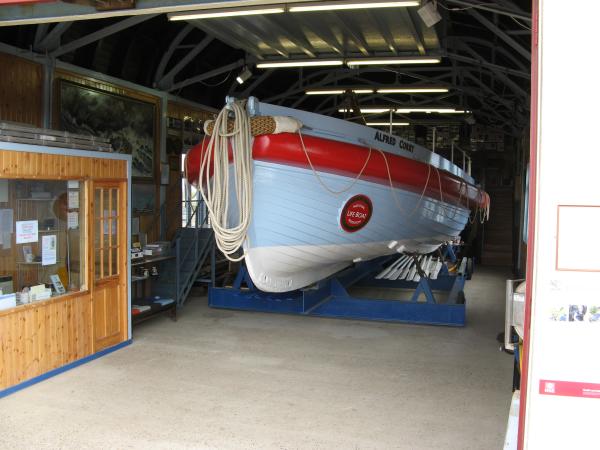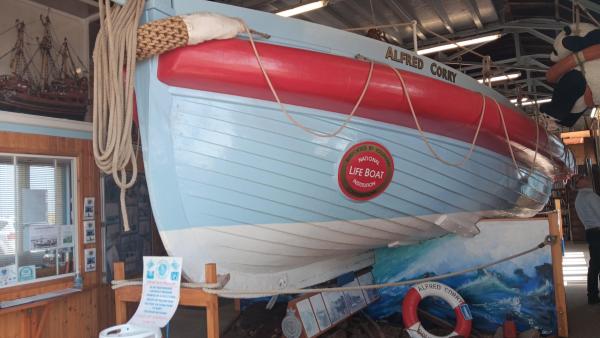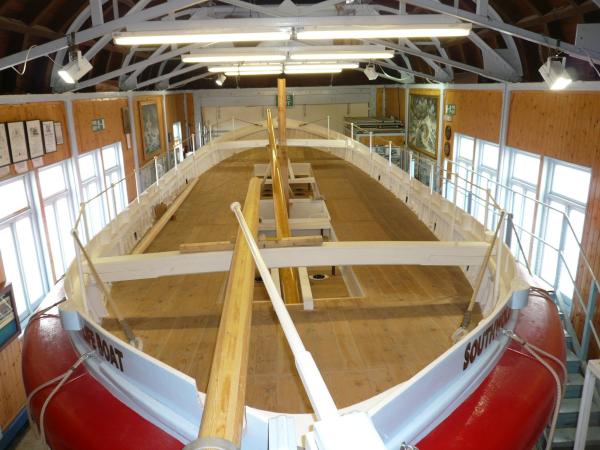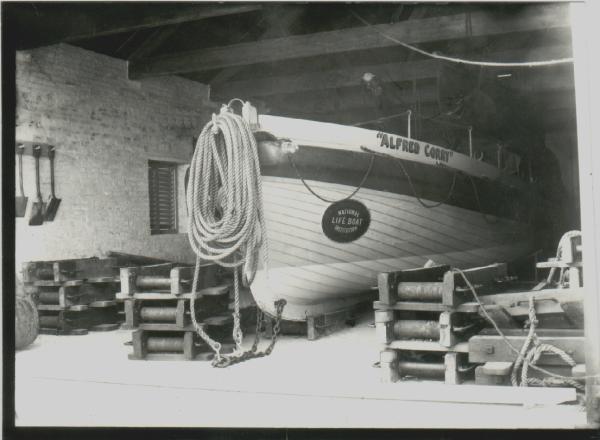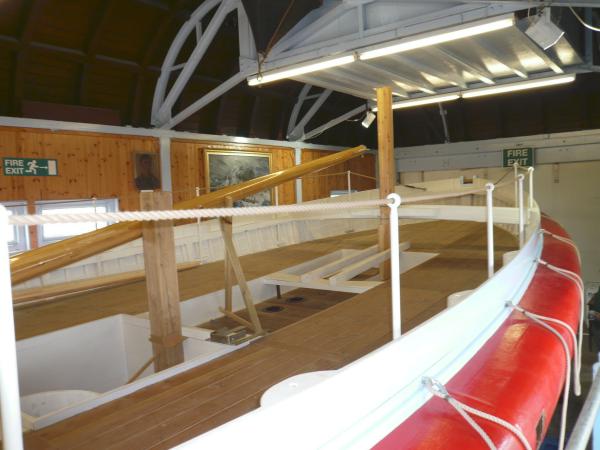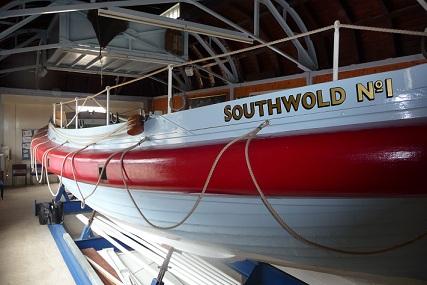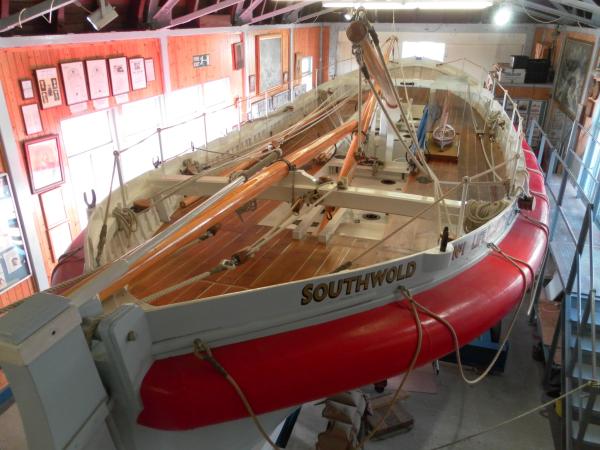

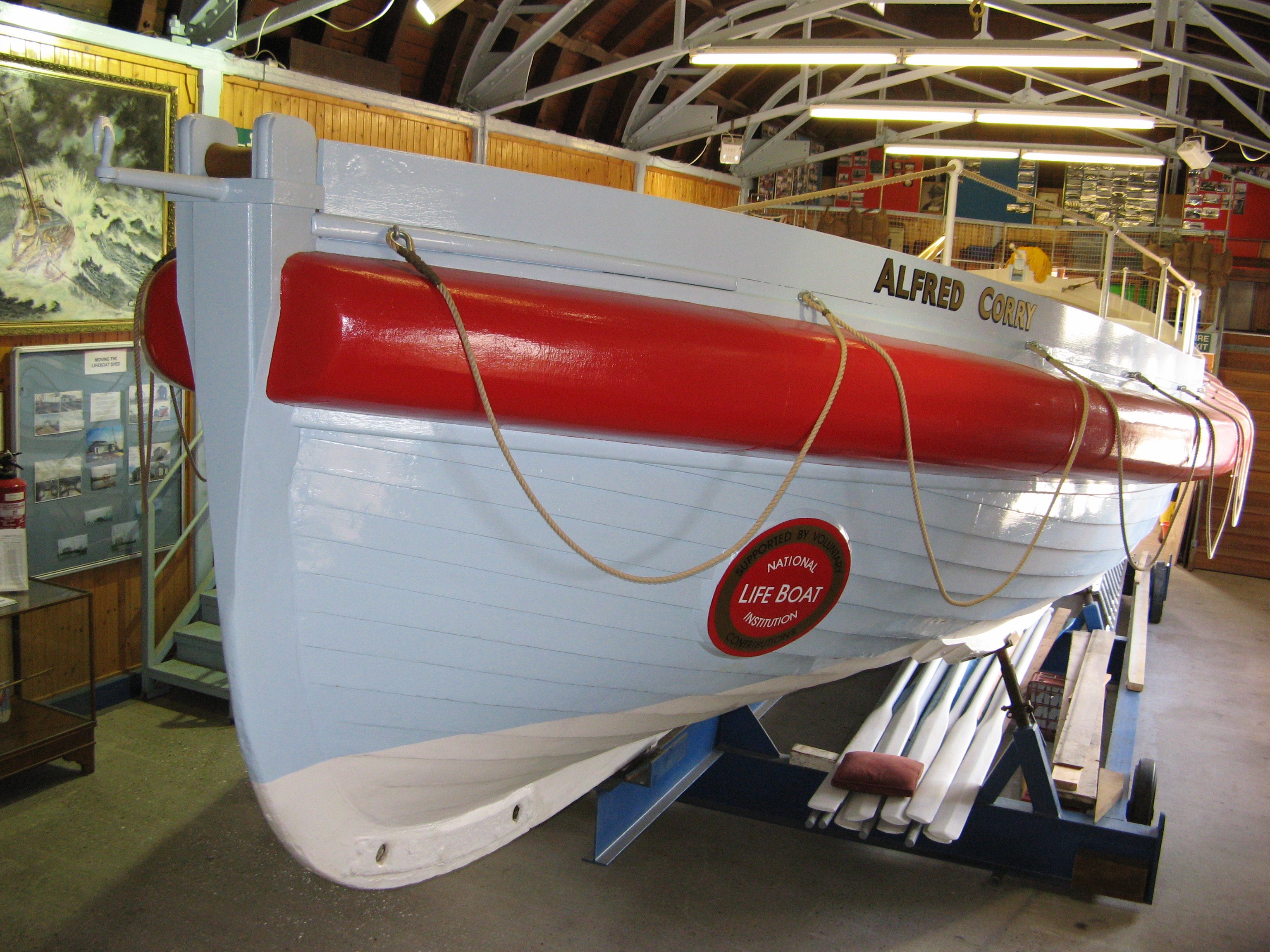
Previous names
- 1893 - 1918 Alfred Corry (RNLI Number ON 353)
- 1918 - 1949 Alba
- 1949 - 1977 Thorfinn
Details
Construction
Dimensions
History
The ALFRED CORRY was built in 1893 by Beeching Brothers of Yarmouth is a 44ft 1in Norfolk & Suffolk sailing and pulling Lifeboat. She is the first of the improved clinker built type. Stationed at Southwold from 1893 to 1918, the ALFRED CORRY had a maximum crew of 18 and was launched from the beach until 1908 when coastal erosion changed the nature of the foreshore. She was then moved to a slipway built in the harbour on the nearby river Blythe estuary.
She was on service 41 times and saved 47 lives under her three Coxswains; John Cragie, Sam May and Charles Jarvis. Coxswain John Cragie received three silver medals for gallantry from the RNLI, the first in 1859, the citation for his second, awarded on 11 July 1895 states:
In recognition of his long and gallant services during the period, about 48 years, in which he has been connected with the boats, firstly as one of the crew, afterwards as Second Coxswain and ultimately as Coxswain, a post John Cragie assumed in 1879. During this period, there were services to the barque NORDENHAVET (1887), the brigantine VECTA (1890), the fishing boat MARY ANN (1892) the barque ALPHA (1893), the barque NINA (1894) and the brig JAMES AND ELEANOR (1895).
On 10 March 1898 he was awarded his third silver medal, which was awarded on Mr Cragie's retirement from the post of Coxswain after many years in the boat. Only one service was rendered after his previous medal, that of assisting the ketch ELIZA AND ALICE (1896).
Under Coxswain Sam May the ALFRED CORRY continued her service and further enhanced the reputation of both boat and crew. In 1905 Sam May and the lifeboat crew were awarded medals by the French government for their “Courage et Devouement” in the rescue of the crew of the JOSEPH ET YVONNE. In 1911 Sam May was awarded a RNLI certificate of service and a pair of binoculars for his part in the locally famous Christmas time rescue of the BERYL. In 1912 Sam May and his crew were awarded Dutch medals for their part in the gallant rescue of the schooner VOORAARTS.
During the course of the First World War ALFRED CORRY was launched a total of 14 times, under sail, saving a total of 15 lives. Her first service of the war was to assist a local fishing boat, the ORIENT, which had got into difficulties off Southold harbour. Her first service resulting from enemy action occurred in the summer of 1915.
At about 8am on 18 July 1915 an explosion was observed on a large steamer, and it was reported that she had been torpedoed. She was the SS BATOUM of Swansea, which was loaded with fuel oil and was carrying a crew of 33, six of whom were killed by the explosion. Some of the crew were seen leaving the stricken vessel in the ship’s boats, but as the vessel lowered in the water the ALFRED CORRY was launched. The ship was eventually refloated and towed into Sheerness, accompanied by a naval escort.
Her largest saving of life occurred on 12 November 1915. Just after daybreak a schooner-rigged vessel, the brigantine JOHN of Grimsby,was observed coming in from the eastward in a gale. She was seen to be in a dangerous position near Sizewell Bank, and the ALFRED CORRY was launched. When the lifeboat reached the ship the captain reported that he had been aground, but on letting go of his anchor the vessel swung clear.
On 11 October 1915 she went to the assistance of the Government Patrol boat AMY on Sizewell Bank. Her last service of the war was on 27 February 1918, when she went to assist a Government Seaplane which had ditched one mile south of Southwold town. In addition to the service provided by ALFRED CORRY, the Southwold Number 2 lifeboat, RESCUE, a rowing lifeboat, was launched on 4 occasions during the war.
During her service life she has just three Coxswains; John Cragie for her first 5 years 1893-1898; Sam May for the next 20 years including her wartime service 1898-1918; and Charles Jarvis for the last 3 months of her service in 1918. Coxswain May was presented with a Certificate of Service on his retirement on 11 October 1918.
In 1939, she was laid up in a mud berth at West Mersea, Essex where she remained for the duration of World War II. A change of ownership and refitting saw her as a well found yacht again and she is reputed to have been the first British yacht to enter Ostend after the war.
In 1949, she was renamed THORFINN and, by 1976, she was derelict as a houseboat in Maldon where she was found and bought by Captain John Cragie, the great grandson of the first Coxswain. Restored by Ian Brown of Rowhedge, Essex, she re-emerged as a fully seaworthy yacht. With permission from the RNLI her name was changed back to the original; ALFRED CORRY.
In 1991, after several more years of cruising, a charitable trust was set up to restore her to her original form as a lifeboat and return her to Southwold. This work was firstly undertaken by the Boatbuilding Training Centre at Lowestoft and completed by a dedicated volunteer team in Southwold. A permanent home in Southwold was provided by the former Cromer lifeboat shed which was towed to its new position in 1998. This 1920s wooden shed with distinctive curved zinc roof was the first of its type to be built by the RNLI and has a history of its own, second to none in the United Kingdom. Source: Alfred Corry Lifeboat Museum Trust records.
Significance
1. What is the vessel’s ability to demonstrate history in her physical fabric?
Evidence for designs, functions, techniques, processes, styles, customs and habits or uses and associations in relation to events and people. How early, intact or rare these features are may impact on significance.
ALFRED CORRY was built as an improved version of the non-self-righting, pulling and sailing Norfolk and Suffolk Class lifeboat, and she has been conserved in this form today. She carries two masts, a dipping lug on the foremast, and a standing lug on the mizzen mast. She holds about 5 tons of water ballast in four tanks, and the total weight of the boat without gear is over eight tons. She was built with places for sixteen oars, although this was later reduced to fourteen oars. She has eighteen relieving tubes and eight scuppers.
Around 90% of her hull is original, with rotten parts having been replaced with Douglas fir. Six replica thwarts have been fitted to provide additional strength to the hull. Replacement timber has been fitted to repair the hull planking and the gunwales amidships. All internal fittings have been replaced. There are no physical traces left of the time she spent as a yacht between 1919 and 1991. The yacht keel which was added in 1919 was later removed and the original lifeboat keel replaced. Wooden parts have been replaced using larch and oak, with Douglas fir used to construct new deck beams. Metal parts are all new, and new ropes have been fitted. Two hollow wooden masts have been fitted in place of earlier solid ones to better convey her original appearance.
2. What are the vessel’s associational links for which there is no physical evidence?
Associations with people or places. Off-ship research.
ALFRED CORRY has a long association with the town of Southwold where she served as the No.1 lifeboat for 25 years, between 1893 and 1918. This connection, along with the heroic service of her coxswains, imbues ALFRED CORRY with considerable regional significance. John Cragie, who was responsible for ALFRED CORRY’s design specification, was one of the best known Coxswains from Southwold. He received three RNLI silver medals, the third of which was granted on his retirement as coxswain of ALFRED CORRY in 1898. He was succeeded by Sam May, who remained as coxswain for twenty years. ALFRED CORRY was launched on service 41 times, and is credited with saving 47 lives. During the First World War she was launched 14 times, under sail, saving a total of 15 lives. Her first service resulting from enemy action occurred in mid-1915, and her last service of the war was in February 1918, when she went to the assistance of a Government Seaplane which had ditched one mile south of Southwold. After being sold out of service to Lord Albemarle in 1919, ALFRED CORRY was converted to a gentleman’s yacht. In this form, she had the distinction of being the first British yacht to enter Ostend after the end of the Second World War. In 1976, her original use became significant again, when she was bought by John Cragie, great grandson of the first coxswain, and an extensive conservation programme was undertaken.
ALFRED CORRY was recorded on the National Register of Historic Vessels in 1996 and given the status of inclusion in the National Historic Fleet.
3. How does the vessel’s shape or form combine and contribute to her function?
Overall aesthetic impact of the vessel, her lines, material she was built from and her setting. Does she remain in her working environment?
ALFRED CORRY was designed with a full bow, to provide lift when launched from an open beach, and a hull shape which would make her fast, safe and comparatively dry at sea when sailing off the wind, which was the type of sailing she would usually be called upon to do in service. She is an excellent example of how a lifeboat was built for a particular use and the conditions she would have had to face on the Norfolk and Suffolk coast. She is now housed in a stable and appropriate heritage environment on public display ashore in the Alfred Corry Museum which is located in the former Cromer lifeboat station at Southwold.
Source: NHS-UK team, 26 August 2015.
This statement was developed as part of the Heritage Lottery funded First World War project. http://www.ww1britainssurvivingvessels.org.uk/
Key dates
- 1893 Built in Great Yarmouth
- 1893-1918 In service as Southwold NO1 Lifeboat
- 1913 Model made and placed in Sothwold Church
- 1918 Sold out of service to J Chambers Yard, Lowestoft and stripped
-
1919
Sold to Lord Albermarle, converted to a “gentleman’s yacht” and renamed Alba
- 1921 Engine fitted Sold to succession of owners
-
1939-1945
Laid up in West Mersea, Essex for the war. New owner First British yacht to enter Ostend after the war
- 1950 Renamed THORFINN and used as a houseboat
-
1976
Bought by John Craigie (great-grandson of Original Coxswain) for retsoration
- 1980 Restored and re-named ALFRED CORRY
- 1994 Returned to Southwold by road for further restoration
- 1998 Installed as the centre piece of the ALFRED CORRY Museum
Sources
Jenkins, Barrat A, Southwold and District Guide, The Southwold Press
Brouwer, Norman J, International Register of Historic Ships, Anthony Nelson, pp134, Edition 2, 1993
Barrett Jenkins, A, A Photographic Collection of Bygones and Local Characters of Southwold, The Southwold Press, 1985
Old Gaffer's Association Member's Handbook and Boat Archive, 1993
Own this vessel?
If you are the owner of this vessel and would like to provide more details or updated information, please contact info@nationalhistoricships.org.uk

